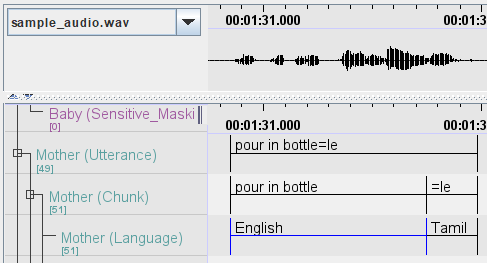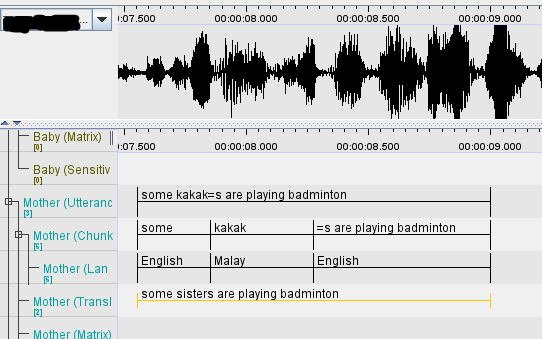List of special codes
Contents
- General Rules
- Introduction to Open Class, Closed Class and Label categories
- Closed Class
- Open Class
- Label
General Rules
-
All of the listed codes will be entered in the Utterance Tier where necessary. They can be included in the chunk tier if they are important for contextual information (e.g., an actual cough versus a fake cough to mimic coughing in a story being read to the child. Include the fake cough.)
-
If included in the chunk tier, all the codes in this list should exist in their own individual cells and be tagged individually in the Language Tier.
Introduction to Open Class, Closed Class and Label categories
These special codes are to be used in the Utterance and Chunk tiers. They can be used for both baby and adult tiers.
- {open class} categories can take normal written characters (alphanumeric, Chinese characters, Tamil characters, etc.), question mark (?) and plus character (+)
- {closed class} categories can only take the list of given examples
- The {label} category is mainly for
:v:l:whereby it can only take alphabets (a-z) and underscores_, eg.:v:l:blowing_sound.
Basically, open class categories are free and easy while closed class categories are restricted to a given list.
Do refer to our BLIP Dictionary for a more comprehensive list of these special codes.
Closed Class
1. Vocal Sounds
:v:{closed class}
:v: is for Vocal Sounds that are not considered speech. All spaces in these codes must be replaced with an underscore.
Examples
| Description | Marking | Tag Under Language Tier |
|---|---|---|
| Laughing | :v:laughter | Vocal Sounds (for adults) , :v:laughter (for babies) |
| Parent shushing the child | :v:shushing_sound | Vocal Sounds |
| Gasping | :v:gasp | Vocal Sounds (for adults), :v:vocalizations (for babies) |
| Making a “tsk” sound | :v:tsk | Vocal Sounds (for adults), :v:vocalizations (for babies) |
| Making animal sounds | :v:animal_sound | Vocal Sounds (for adults), :v:vocalizations (for babies) |
| Making orangutan sounds | :v:orangutan_sound | Vocal Sounds (for adults), :v:vocalizations (for babies) |
| Making flamingo sounds | :v:flamingo_sound | Vocal Sounds (for adults), :v:vocalizations (for babies) |
| Making elephant sounds | :v:elephant_sound | Vocal Sounds (for adults), :v:vocalizations (for babies) |
| Coughing | :v:coughing | Vocal Sounds (for adults), :v:airstream (for babies) |
| Whistling | :v:whistle | Vocal Sounds |
| Sighing | :v:sigh | Vocal Sounds (for adults), :v:vocalizations (for babies) |
| Making a train sound | :v:train_sound | Vocal Sounds (for adults), :v:vocalizations (for babies) |
| Making a kissing sound | :v:kissing_sound | Vocal Sounds (for adults), :v:vocalizations (for babies) |
| Making thunder sounds | :v:thunder_sound | Vocal Sounds (for adults), :v:vocalizations (for babies) (Note: if speaker can clearly be heard saying ‘boom’, tag that utterance as English and transcribe without the :v: convention) |
| Making rain sounds | :v:rain_sound | Vocal Sounds (for adults), :v:vocalizations (for babies) (Note: if speaker can clearly be heard saying ‘pitter-patter’, tag that utterance as English and transcribe without the :v: convention) |
| Making lightning sounds | :v:lightning_sound | Vocal Sounds (for adults), :v:vocalizations (for babies) |
| Making screaming sounds | :v:screaming_sound | Vocal Sounds (for adults), :v:vocalizations (for babies) |
| Making ringing sounds | :v:ringing_sound | Vocal Sounds (for adults), :v:vocalizations (for babies) (Note: if speaker can clearly be heard saying ‘ring-ring’ or ‘ding-dong’, tag that utterance as English and transcribe without the :v: convention) |
| Making a splash sound | :v:splash_sound | Vocal Sounds (for adults), :v:vocalizations (for babies) (Note: if speaker can clearly be heard saying ‘splash’, ‘splish-splash’ or ‘splosh’, tag that utterance as English and transcribe without the :v: convention) |
:v:x
:v:x is to be used for vocal sounds that cannot be described or difficult to label even with context. It is a standalone token.
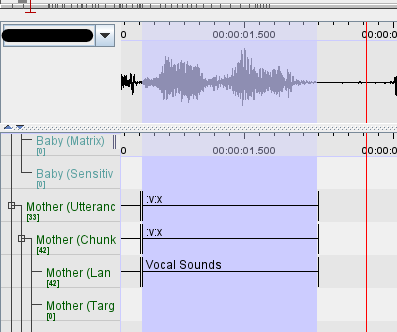
Back to table of contents
2. Non-Vocal Sounds
:s:{closed class}
:s: is for non-vocal Sounds. Tag these articles as “Non Vocal Sound” under the Language Tier.
Examples
| Description | Marking | Tag on Language Tier |
|---|---|---|
| Clapping | :s:clapping | Non Vocal Sounds |
| Clicking objects together | :s:clicking | Non Vocal Sounds |
| Sniffing | :s:sniff | Non Vocal Sounds |
| Sneezing | :s:sneeze | Non Vocal Sounds |
| Syncing click at the beginning of every sound file | :s:sync | Exception. No need tag on language Tier. Instead of encoding this code on the Utterance Tier, encode this on the Transcriber (Comments) Tier. |
:s:x
:s:x is a standalone token and is to be used for unclassified non-vocal sounds. Such sounds include intentional and/or relevant sounds made by parent during the recording (e.g., toy rattling, banging on table to attract the child’s attention).
If there are non-intentional sounds made by baby, there is no need to mark it (e.g., baby banging on table). Other non-intentional sounds should also be ignored (e.g., water bottle dropping, chair scrapping).
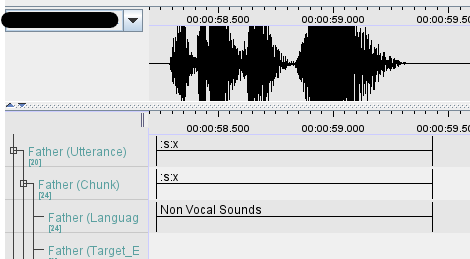
Do note that the sparkling sound that denotes the storybook page turning in the Talk Together Study Video Call Storytime should not be transcribed.
Back to table of contents
3. Discourse Markers
:d:{closed class}
:d: is for discourse markers
Discourse markers are sentence endings like “la”, “lor”, “leh”, or “hor”. They have a Language tier tag of ‘Red Dot’.
Examples
| Description | Marking |
|---|---|
| Adult or baby uses a discourse marker in their speech | :d:lah |
List of Discourse Markers
- ah
- eh
- har/huh
- hor
- lah
- leh
- liao
- lor
- ma
- na/nah
- neh
- orh
- sia
Do refer to our BLIP Dictionary for a more comprehensive list with examples. If you notice anymore instances while transcribing, inform your supervisor at the next transcription meeting.
Back to table of contents
Open Class
1. Unclassifiable Vocal Sounds
:v:u:{open class}
:v:u: is used to designate Vocal Sounds that cannot be classified. When transcribing these, type v:u then a colon, then transcribe the actual words after the second colon. Try not to use this tag unless it does sound like a transcribable word. All spaces are to be replaced with a plus sign +
Back to table of contents
2. Repeated Vocal Sounds
:v:r:{open class}
For when the adult individual makes a repeated rhythmic sound. It can only be classed as a vocal sound, however because we do not want to lose the transcribable data, code it first as :v:r, then add another colon at the back and transcribe the contents of the utterance.
For instance the rhythm goes dadadada.
Code it as :v:r:da+da+da+da.
Note that before coding this you should check that this is not a case of mimicking.
Back to table of contents
3. Singing
:si:{open class}
:si: is just for singing. All space between lyrics must be replaced by “+”. Tag this in the Language Tier as whatever Language tag is applicable. This means if the individual is singing in English, tag it in the Language Tier as English, but if the individual is singing nonsensical syllables, tag is as “Vocal Sounds”.
Examples
| Description | Marking | Tag on Language Tier |
|---|---|---|
| Singing | :si:mary+had+a+little+lamb | Relevant Language. “Vocal Sounds” if nonsense syllables |
| Humming | :si:humming | Vocal Sounds |
If the speaker is singing a mix of words and nonsensical syllabus (eg. baby shark du du du du), it should be annotated as shown below. The words :si:baby+shark will be in one annotation cell while :si:du+du+du+du will be in another annotation cell.
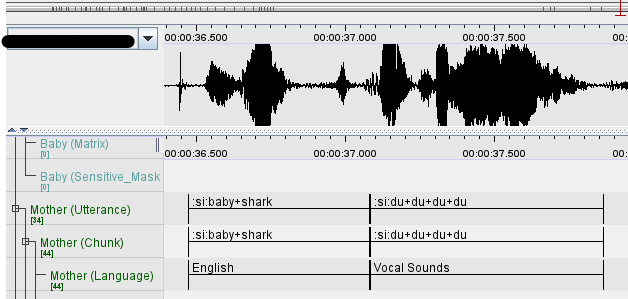
It should not be annotated as one utterance together (as shown below):
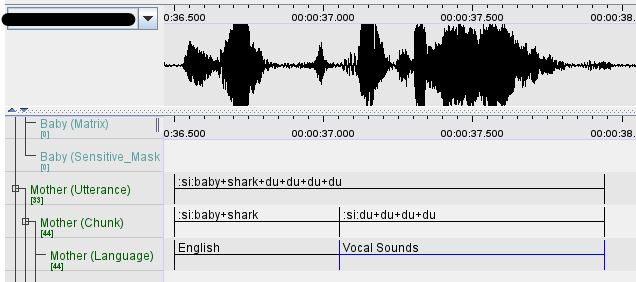
Back to table of contents
4. Mimicking
:m:{open class} and :m:{special code}:{open class}
:m: is for mimicking. All space between words must be replaced by “+”. Special codes include the ones listed on this wiki page e.g. v for vocal sounds, d for discourse marker, etc.
Tag this in the Language Tier as whatever Language tag is applicable. This means if the individual is mimicking English words, tag it in the Language Tier as English, but if the individual is mimicking nonsense syllables, tag is as “Vocal Sounds”.
| Description | Marking | Tag on Language Tier |
|---|---|---|
| Parent Mimicking Child vocalization | :m:banana | Relevant Language. “Vocal Sounds” if nonsense syllables |
| Parent mimicking child singing | :m:si:rain+rain+go+away | Relevant language. “Vocal Sounds” if nonsense syllables |
| Parent mimicking use of discourse marker | :m:d:lah | Red-dot |
If the baby is mimicking an adult speaking, note it in the “Baby (Utterance)” and “Baby (Chunk)” tiers with :m: preceding the mimicked word/utterance e.g., :m:baba if the baby was mimicking an adult saying baba
Back to table of contents
5. Loanwords
:l:langname:{open class}
This is for Loanwords.
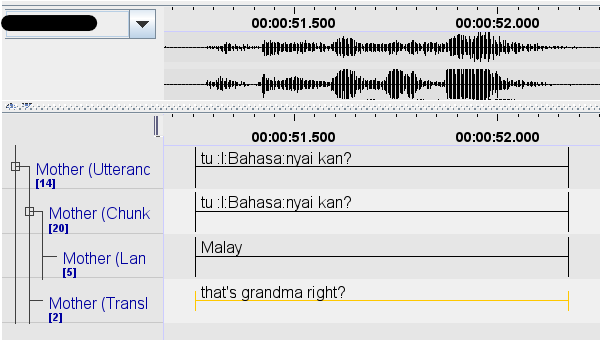
If a word is borrowed into a different language from the main utterance language, it should be separated in the Chunk tiers and tagged accordingly. Below is an example where ummi is an Arabic term but was borrowed into Malay.
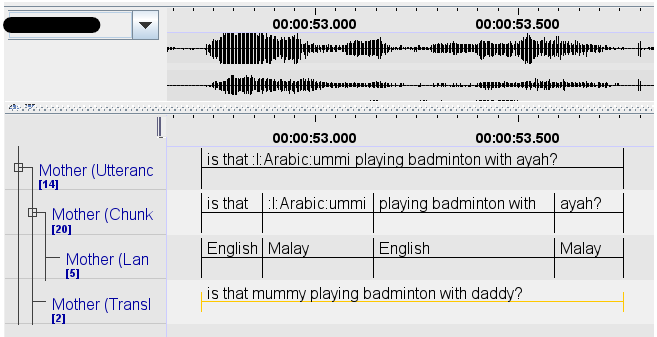
If one is unsure of what the loanword is and/or unsure of what language it should be tagged in, #!#? should be annotated in the Utterance, Chunk and Language tiers.
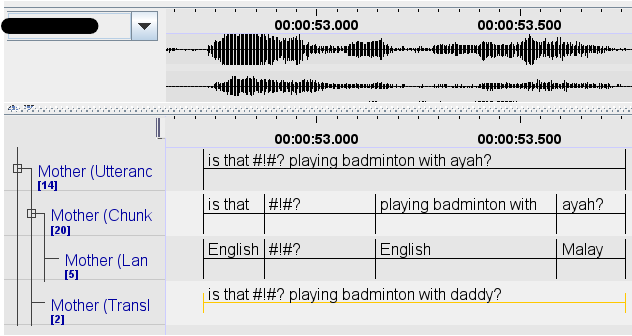
For more strange loanwords such as “sabo” just put it as a loanword from English.

Back to table of contents
6. Bound Morphemes
={open}
This is for Bound Morphemes.
Bound Morphemes
Bound morphemes are classed as =BoundMorpheme. So if the Bound morpheme is =le, it will be Mainword =le.
If the bound morpheme comes from a different language, tag the language accordingly.
Here are more examples of bound morphemes:

Bound morphemes that occur at start of word will still be tagged with =
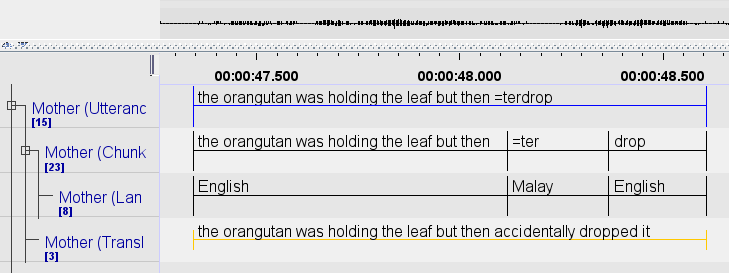
Back to table of contents
7. Unclear or unknown language
#!#langname and #!#?
Unclear language will be noted as #!#langname in the Language tier, #!#Bahasa for example.
Completely unknown language will be noted as #!#? in the Language tier.
Back to table of contents
8. Special Cases
Special cases will be addressed here as and when they pop up.
In the case of a person singing an animal sound, class it as Singing then type in the words. Because the Singing class is an open class category. This means singing of an animal sound will be coded as :si:quack+quack+quack+quack. Tag it under Language as “Vocal Sound”.
Back to table of contents
Label
1. General Vocal Sounds that can be described
:v:l:{label_name}
:v:l: is for sounds that are currently not in our closed class vocal sounds list e.g., blowing sound, eating sound, tongue clicking, blowing raspberries etc. Labels are not standardised and are open for description.
Labels after :v:l: should only be in lowercase characters (a-z) and spaces are to be replaced with underscores _

Note that :v:l:gasping_sound is NOT accepted as we already have :v:gasp
Back to table of contents
